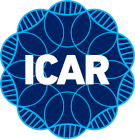Merging and sharing data in genetic evaluations
Early 2016 an attempt to make cross country evaluations of CH4 emissions from Holstein dairy cattle was initiated. The work was based on data from NL, DK, AUS, UK and IR. In total, 12,820 weekly CH4 emission records from 2,857 cows were available. Although different equipment was used across countries to measure CH4 emissions, the research aimed to define similar CH4 output phenotypes in each country. The analysed CH4 traits, that are available in each country, are (1) CH4 production in g/d, and (2) CH4 intensity in g/d per kg fat protein corrected milk (FPCM). In addition to these CH4 traits, CH4 concentration (in ppm) was available in Denmark, the Netherlands and UK, and the ratio between CH4 and CO2 concentration was available in Denmark and the Netherlands.
Bivariate analyses were carried out to estimate genetic correlations between countries, using an animal linear mixed model for all traits. Both univariate and bivariate analyses were repeated with the GRM as well. With all weekly records, standardizing the trait in the full dataset increased the heritability for CH4 production from 0.03 to 0.06. The heritability for CH4 intensity was slightly higher. The highest heritability with the full dataset is estimated for the standardized CH4 concentration (0.19). Correlations estimated among CH4 traits estimated with either the pedigree or the GRM were in same direction and of similar magnitude. The genetic correlations show that when CH4 production increased, the CH4 concentration and the ratio between CH4 and CO2 increased as well.
The approach is novel, and no other attempt has been performed to make genetic analysis of CH4 traits across countries. The analysis can be repeated in future studies where more data hopefully will be available, and more effort can be made into improving both the fixed and random part of the model.
